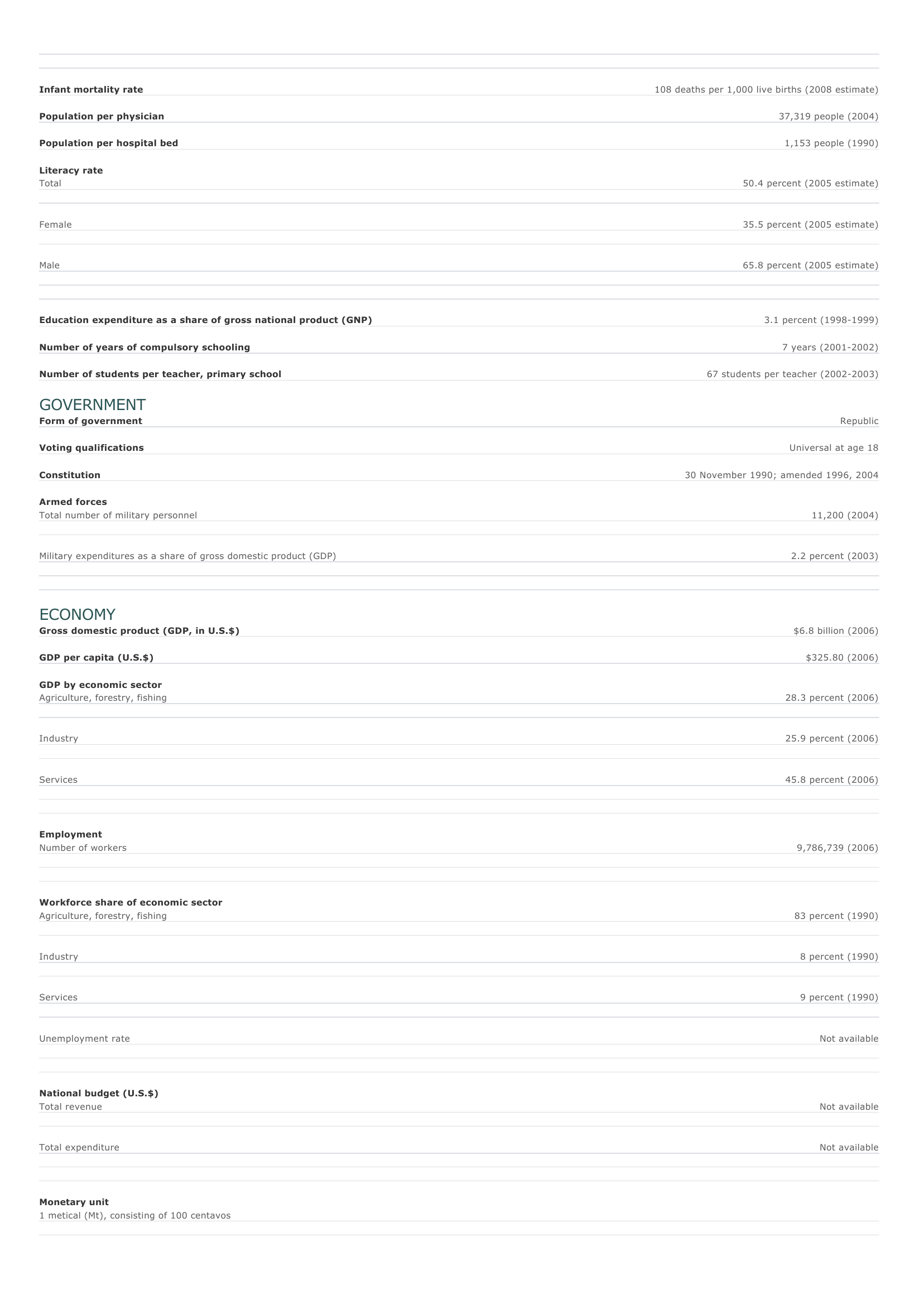
Mozambique Facts and Figures. BASIC FACTS Official name Capital Area Republic of Mozambique Maputo 799,380 sq km 308,642 sq mi PEOPLE Population 21,284,701 (2008 estimate) Population growth Population growth rate 1.79 percent (2008 estimate) Projected population in 2025 28,893,271 (2025 estimate) Projected population in 2050 41,842,274 (2050 estimate) Population density 27 persons per sq km (2008 estimate) 70 persons per sq mi (2008 estimate) Urban/rural distribution Share urban 38 percent (2005 estimate) Share rural 62 percent (2005 estimate) Largest cities, with population Maputo 1,221,000 (2003 estimate) Matola 440,927 (1997) Beira 412,588 (1997) Nampula 314,965 (1997) Chimoio 177,608 (1997) Ethnic groups Makua, Yao, Makonde, Tonga, Tsonga, Chopi, Shona, Nguni, others Languages Portuguese (official); Swahili, indigenous dialects, including Makua, Ronga, Tsongan, and Muchope Religious affiliations Indigenous beliefs 50 percent Christian 38 percent Muslim 11 percent O ther 1 percent HEALTH AND EDUCATION Life expectancy Total 41 years (2008 estimate) Female 40.4 years (2008 estimate) Male 41.6 years (2008 estimate) Infant mortality rate Population per physician Population per hospital bed 108 deaths per 1,000 live births (2008 estimate) 37,319 people (2004) 1,153 people (1990) Literacy rate Total 50.4 percent (2005 estimate) Female 35.5 percent (2005 estimate) Male 65.8 percent (2005 estimate) Education expenditure as a share of gross national product (GNP) Number of years of compulsory schooling Number of students per teacher, primary school 3.1 percent (1998-1999) 7 years (2001-2002) 67 students per teacher (2002-2003) GOVERNMENT Form of government Republic Voting qualifications Universal at age 18 Constitution Armed forces Total number of military personnel Military expenditures as a share of gross domestic product (GDP) 30 November 1990; amended 1996, 2004 11,200 (2004) 2.2 percent (2003) ECONOMY Gross domestic product (GDP, in U.S.$) GDP per capita (U.S.$) $6.8 billion (2006) $325.80 (2006) GDP by economic sector Agriculture, forestry, fishing 28.3 percent (2006) I ndustry 25.9 percent (2006) Services 45.8 percent (2006) Employment Number of workers 9,786,739 (2006) Workforce share of economic sector Agriculture, forestry, fishing 83 percent (1990) I ndustry 8 percent (1990) Services 9 percent (1990) Unemployment rate Not available National budget (U.S.$) Total revenue Not available Total expenditure Not available Monetary unit 1 metical (Mt), consisting of 100 centavos Major trade partners for exports Belgium, South Africa, Spain, Zimbabwe, and Japan Major trade partners for imports South Africa, Portugal, Australia, United States, and Pakistan ENERGY, COMMUNICATIONS, AND TRANSPORTATION Electricity production Electricity from thermal sources Electricity from hydroelectric sources 0.95 percent (2003 estimate) 99.05 percent (2003 estimate) Electricity from nuclear sources 0 percent (2003 estimate) Electricity from geothermal, solar, and wind sources 0 percent (2003 estimate) Number of radios per 1,000 people 40 (1997) Number of telephones per 1,000 people 4 (2004) Number of televisions per 1,000 people 5.4 (2000 estimate) Number of Internet hosts per 10,000 people Daily newspaper circulation per 1,000 people Number of motor vehicles per 1,000 people Paved road as a share of total roads 1.7 (2003) 2 (1998) 0.8 (1997) 19 percent (1999) SOURCES Basic Facts and People sections Area data are from the statistical bureaus of individual countries. Population, population growth rate, and population projections are from the United States Census Bureau, International Programs Center, International Data Base (IDB) (www.census.gov). Urban and rural population data are from the Food and Agriculture Organization (FAO) of the United Nations (UN), FAOSTAT database (www.fao.org). Largest cities population data and political divisions data are from the statistical bureaus of individual countries. Ethnic divisions and religion data are largely from the latest Central Intelligence Agency (CIA) World Factbook and from various country censuses and reports. Language data are largely from the Ethnologue, Languages of the World, Summer Institute of Linguistics International (www.sil.org). Health and Education section Life expectancy and infant mortality data are from the United States Census Bureau, International Programs Center, International database (IDB) (www.census.gov). Population per physician and population per hospital bed data are from the World Health Organization (WHO) (www.who.int). Education data are from the United Nations Educational, Scientific and Cultural Organization (UNESCO) database (www.unesco.org). Government section Government, independence, legislature, constitution, highest court, and voting qualifications data are largely from various government Web sites, the latest Europa World Yearbook, and the latest Central Intelligence Agency (CIA) World Factbook. The armed forces data is from Military Balance. Economy section Gross domestic product (GDP), GDP per capita, GDP by economic sectors, employment, and national budget data are from the World Bank database (www.worldbank.org). Monetary unit, agriculture, mining, manufacturing, exports, imports, and major trade partner information is from the statistical bureaus of individual countries, latest Europa World Yearbook, and various United Nations and International Monetary Fund (IMF) publications. Energy, Communication, and Transportation section Electricity information is from the Energy Information Administration (EIA) database (www.eia.doe.gov). Radio, telephone, television, and newspaper information is from the United Nations Educational, Scientific and Cultural Organization (UNESCO) database (www.unesco.org). Internet hosts, motor vehicles, and road data are from the World Bank database (www.worldbank.org). Note Figures may not total 100 percent due to rounding. Microsoft ® Encarta ® 2009. © 1993-2008 Microsoft Corporation. All rights reserved.











